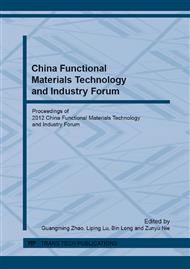p.214
p.220
p.226
p.230
p.235
p.241
p.251
p.255
p.259
Effects of Al2O3 Coating on the Structural and Electrochemical Performance of LiNi0.5Co0.2Mn0.3O2 Cathode Material
Abstract:
The pristine LiNi0.5Co0.2Mn0.3O2 cathode material particles were successfully coated with Al2O3 via a heterogeneous nucleation process and subsequent heat-treatment. The structure and electrochemical properties of Al2O3-coated LiNi0.5Co0.2Mn0.3O2 were characterized by XRD and constant-current charge/discharge cycling tests. It was found that the Al2O3 coating did not alter the crystal structure of the cathode material. The Al2O3 coating layer had a negative influence on the dicharge specific capacity and a positive effect on the cycling performance. The decreased discharge capacity of the coated sample can be attributed to the poor clectronic and ionic conductivity of Al2O3 layer, which interfered the Li+ intercaltion/deintercaltion into/from the cathode material. The enhanced cycling performance can be ascribed to the suppression of the dissolution of transition metal ions by the HF acid in the eletrolyte and the side reations between electrode and electrolyte by the Al2O3 coating layer. The 2wt.% Al2O3-coated sample exhibits the optimal overall electrochemical performance, with discharge specific capacities of 157.0, 137.1 mAh/g at 0.2C and 3C rate, and capacity cycling retention rates of 97.34, 93.53% after 20 & 50 cycles, respectively.
Info:
Periodical:
Pages:
235-240
Citation:
Online since:
May 2013
Authors:
Price:
Сopyright:
© 2013 Trans Tech Publications Ltd. All Rights Reserved
Share:
Citation:


